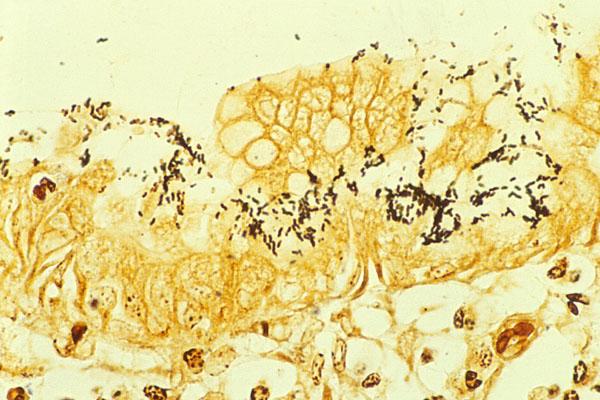Warthin–Starry Stain on:
[Wikipedia]
[Google]
[Amazon]

 The Warthin–Starry stain (WS) is a
The Warthin–Starry stain (WS) is a

 The Warthin–Starry stain (WS) is a
The Warthin–Starry stain (WS) is a silver nitrate
Silver nitrate is an inorganic compound with chemical formula . It is a versatile precursor to many other silver compounds, such as those used in photography. It is far less sensitive to light than the halides. It was once called ''lunar caustic' ...
-based staining
Staining is a technique used to enhance contrast in samples, generally at the microscopic level. Stains and dyes are frequently used in histology (microscopic study of biological tissues), in cytology (microscopic study of cells), and in the ...
method (a silver stain In pathology, silver staining is the use of silver to selectively alter the appearance of a target in microscopy of histological sections; in temperature gradient gel electrophoresis; and in polyacrylamide gels.
In traditional stained glass, silve ...
) used in histology. It was first introduced in 1920 by American pathologists Aldred Scott Warthin
Aldred Scott Warthin (October 21, 1866 − May 23, 1931) was an American pathologist whose research laid the foundation for understanding the heritability of certain cancers. He has been described as "the father of cancer genetics."
Early life an ...
(1866-1931) and Allen Chronister Starry (1890-1973), for the detection of spirochete
A spirochaete () or spirochete is a member of the phylum Spirochaetota (), (synonym Spirochaetes) which contains distinctive diderm (double-membrane) gram-negative bacteria, most of which have long, helically coiled (corkscrew-shaped or s ...
s. It has been considered a standard stain for the detection of spirochetes, and is also used to stain ''Helicobacter pylori
''Helicobacter pylori'', previously known as ''Campylobacter pylori'', is a gram-negative, microaerophilic, spiral (helical) bacterium usually found in the stomach. Its helical shape (from which the genus name, helicobacter, derives) is though ...
'', ''Lawsonia intracellularis
''Lawsonia intracellularis'' is a species of bacterium. It is obligately intracellular and was isolated from intestines of pigs with proliferative enteropathy disease.
Pathogenicity
''Lawsonia (bacterium), Lawsonia intracellularis'' is highly p ...
'', ''Microsporidia
Microsporidia are a group of spore-forming unicellular parasites. These spores contain an extrusion apparatus that has a coiled polar tube ending in an anchoring disc at the apical part of the spore. They were once considered protozoans or prot ...
'', and particulate
Particulates – also known as atmospheric aerosol particles, atmospheric particulate matter, particulate matter (PM) or suspended particulate matter (SPM) – are microscopic particles of solid or liquid matter suspended in the air. The ter ...
s. It is also important for confirmation of ''Bartonella henselae
''Bartonella henselae'', formerly ''Rochalimæa henselae'', is a bacterium that is the causative agent of cat-scratch disease ( bartonellosis).
''Bartonella henselae'' is a member of the genus ''Bartonella'', one of the most common types of bacte ...
'', a causative organism in cat-scratch disease
Cat-scratch disease (CSD) or felinosis is an infectious disease that most often results from a scratch or bite of a cat. Symptoms typically include a non-painful bump or blister at the site of injury and painful and swollen lymph nodes. People m ...
.
Warthin–Starry stains organisms dark brown to black, and the background light golden brown/golden yellow.
See also
* Dieterle stainReferences
External links
* Staining {{Microbiology-stub